In January, Jeannette and I headed to Hawai’i for our winter vacation. Like all of our vacations, birding is first and foremost, but local food is a close second. And beer. Oh yeah, and Jeannette was also running a marathon.
In 2013, we visited Oahu and Kauai, which I recounted in this blog. This time, it was Maui and the Big Island.
The Big Island is special to me, as my first field job out of college was there, working with the Palila. Seeing this endangered, finch-billed honeycreeper was one of the primary motivations of the trip, as Jeannette had not seen it before. Nor had she seen hot molten magma. I also left the island without seeing two of its endangered endemics. And neither of us had yet been to Maui, which featured another three endemics.
So off we went.
After an 11-hour non-stop flight from NY’s JFK, we arrived in Honolulu. It did, however, take me all of those 11 hours to confirm that the familiar-looking face just one row in front of me was my cousin Gloria that I hadn’t seen in 25-30 years! What are the chances!
We reconnected briefly, and then went our separate ways for now. Common Mynas, Zebra Doves, and Cattle Egrets greeted our arrival to the 50th state, but it was dark by the time Jeannette and I landed on Maui – about 20 hours of travel later.
1/13: Day 2/Day 1 of actual vacation.
Needless to say, it was not an early start, but we did eventually motivate and get things started the right way, with macadamia nut pancakes.

We then checked out the Kanaha Pond Wildlife Sanctuary near our hotel, where we were greeted by Pacific Golden-Plovers (Kolea) on the path…

…and much to our surprise, a wayward flock of 6 immature Snow Geese.

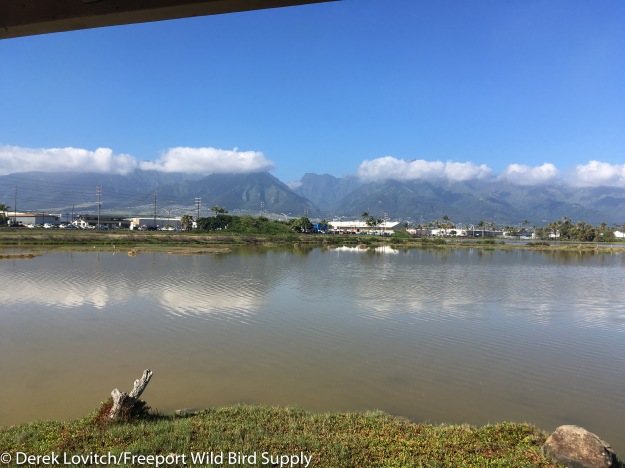
After our first plate lunch, in Kihei, we checked a nearby wetland, where Jeannette got here lifer African Silverbill and photographed from Scaly-breasted Munias.
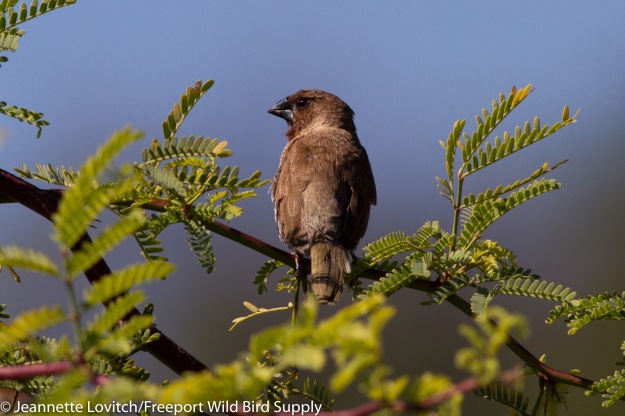
We then spent a few hours birding the Coastal Boardwalk of the Kealia Ponds National Wildlife Refuge…

..enjoying Hawaiian Coots and “Hawaiian” Black-necked Stilts,

…a plethora of Black-crowned Night-Herons,

…and no small number of Cattle Egrets.
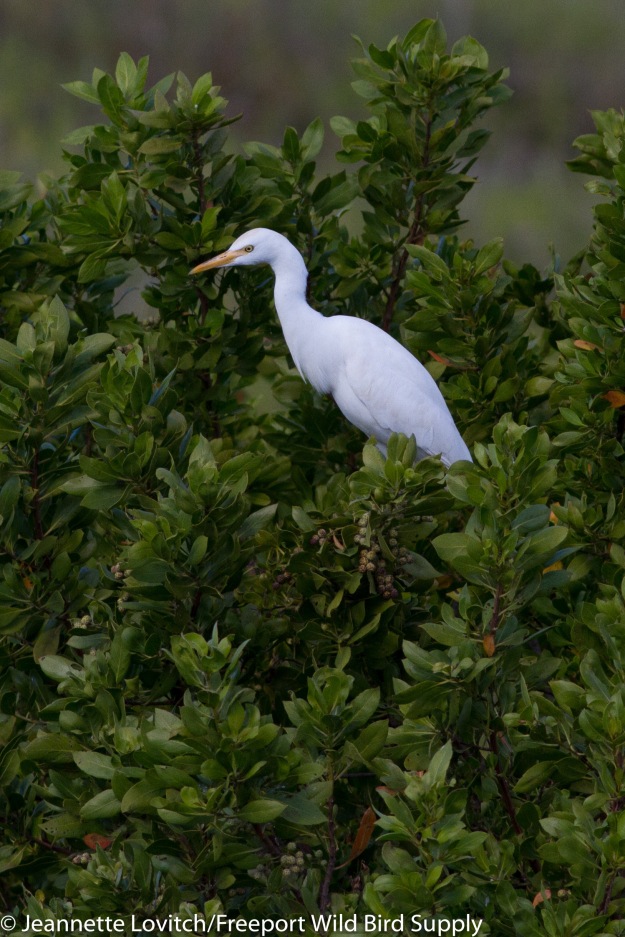
We spent a while in the shade of the viewing platform at the end,

…when I began to shout to Jeannette, “Large Gull! Take Photo!”


After some review later and consulting others, it was clear that this was indeed a 2nd-cycle Slaty-backed Gull – a real mega-rarity for the islands, and quite possibly the first on Maui. Not that we came to Hawai’i to see a Siberian bird, but still! And since the mechanisms of vagrancy fascinate me – especially how they result in the colonization of islands and the eventual adaptive radiation that leads to mind-blowing speciation (and specialization) – and are one of my primary interests in visiting islands as we so often do, this discovery was not only thrilling, but also fit the theme of why we were here.
We decided to celebrate at Maui Brewing Company, which included one of my favorite – and Jeannette’s most favorite- brew of the trip, the Imperial Coconut Porter.

…followed by a delicious dinner at Da Kitchen, where the ubiquitous spam musubi was taken to a whole ‘nother level with a panko crust and a little deep-frying!

1/14: Haleakala National Park
This was a relaxed day of sight-seeing and casual birding in Haleakala National Park. What a remarkable place!

While Chukar was the only bird we saw in and around the crater,

…we did have some good birding a short distance downhill at Hosmer Grove.

There, we caught up with Jeannette’s lifer Hawai’i Amakihis (a possible future split), and our first endemic, the Maui ‘Alauahio.

Gorgeous I’iwis and Apapanes were impressively abundant, with many of the I’iwis dropping down from the tall, non-native trees to feed in the Mamane tree blossoms in the native scrub-forest.

1/15: Race Day!
Jeannette was a little busier today than I, partaking in the Maui Oceanfront Marathon, starting in the dark at 5:00am and finishing (a new personal record) 3:57:17 later.

A swim at the beach was followed by an absolutely outstanding lunch at Star Noodle, including these pork katsu buns…

Kohola Brewery was our next stop – Jeannette earned it (and I had to drive here there), which offered what turned out to be my favorite beer of the trip, their Mighty 88 DIPA.
Afterwards, we took the twisting and turning our way around the north side of the island back to Kahului.
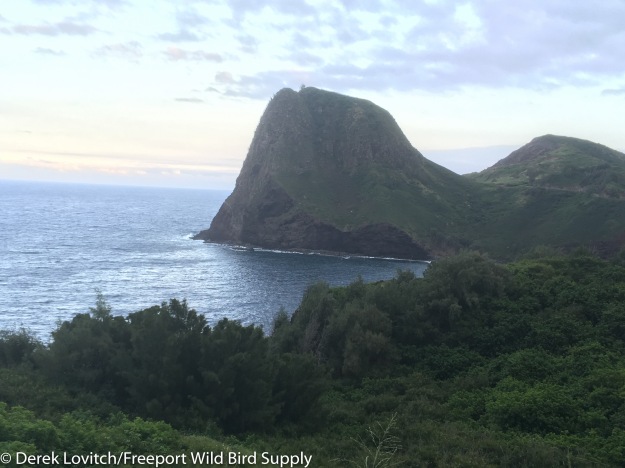
1/16: Waikamoi.
Today was a special day for us. Thanks to our connection to Chuck, a docent for the Nature Conservancy on Maui, we were granted permission to join him on a tour of the famous Waikamoi Preserve. Some years ago, Chuck actually hired me to show him his lifer Nelson’s and Saltmarsh Sparrows here in Maine, and then we reconnected in the restaurant of the Asa Wright Nature Center in Trinidad!

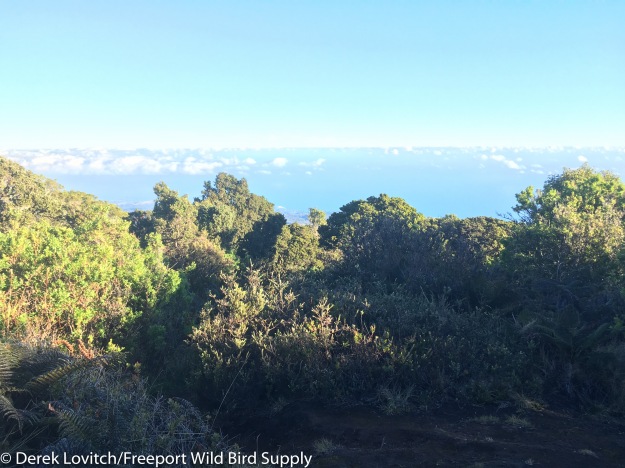
This was our one chance of the trip for the two critically endangered endemics on Maui: the Akohekohe and the Maui Parrotbill. As we spent a good couple of hours waiting, watching, and listening from the platform.

Unfortunately, wind and a lack of Ohia blossoms likely impacted our birding, and we only glimpsed two quick fly-bys of the Akohekoke. The shape, size, and overall dark color eliminated anything else, but even though the looks were good enough to identify, Jeannette and I decided we didn’t want to count it.
We also heard a Maui Parrotbill, but with a 6-acre territory, the chance of spotting one of these inconspicuous mid-story-dwellers was not good. We did see plenty of Maui ‘Alauahio, however, and regardless, we felt truly privileged to even have the opportunity to visit this special place.
Of course, the day after a marathon, Jeannette could have done with a few less than the 250+ stairs!

After a little picnic, Jeannette and I poked around Hosmer Grove some more, working on photographs of Apapane…

..and I’iwi.


We worked our way downhill, into the adorable little town of Paia. There, we rendezvoused with our friend Amanda – the former cook of the Schooner French here in Maine, on which we take our Birding by Schooner tour – who flew in from Kauai just to say hi. OK, and join us for an amazing dinner at The Mill House, where local ingredients and flavors were taken up a few notches.
1/17: Last day on Maui.
Amanda joined us for a little casual birding at Kahana Pond, where we once again ran into the flock of Snow Geese.

Jeannette and I then headed back to Kealia Ponds NWR, to visit the interior portion of the refuge.

Chock full of Hawaiian Coots,

…Black-crowned Night-Herons,


…tons of “Hawaiian” Black-necked Stilts,

..and a really great variety of ducks. A vagrant Great Blue Heron was spotted – another nice addition to my Hawaii state list.
We then made a cultural stop at the Sugar Museum on our way back to town.

Tin Roof, the restaurant of Top Chef contestant Sheldon Simeon, was our lunchtime destination, and it most definitely did not disappoint.

And with a little extra time before our flight, we checked out the backside of Kahana Pond, where we literally were attacked by a very defensive Nene.

While the video does the encounter more justice, I can assure you, we did NOT pass this sign! If we had, we might not have survived.
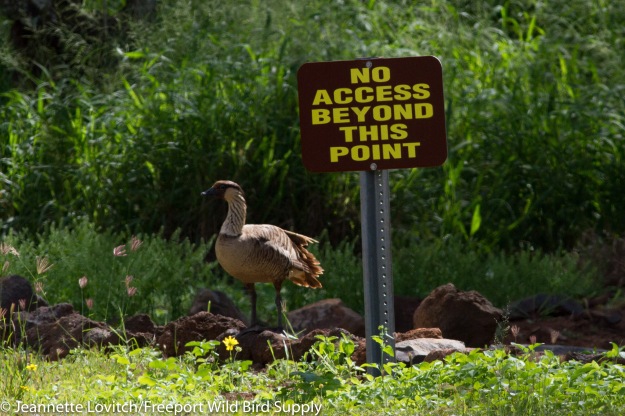
A Belted Kingfisher was yet another rarity for us to discover – although I later learned it was probably a bird that was around for a little while. We also took some time to photograph some of the introduced birds, like Common Mynas.

And then it was off to the Big Island for the second half of our trip.
1/18: Hakalua National Wildlife Refuge
We joined a tour with Hawai’i Forest and Trails in order to venture up the slope of Mauna Kea – on the opposite side of the mountain where I worked with the Palila – and into the wet forest of Hakalau National Wildlife Refuge in search of the two endemics that I have not seen, and a few more lifers for Jeannette.
The howling winds in the saddle caused some consternation, but we arrived at the Puu Akala tract of the Hakalau NWR under crystal-clear skies and without even a puff of wind. In addition to being incredibly gorgeous, weather-wise, the mature forest of massive Koa and flowering Ohia trees was just chock-full of birds.

There were lots of I’iwis and Apapanes, and plenty of Hawai’i Amakihis.

But a mere 15 minutes into the hike, the primary quarry for many, the critically endangered Akiapola’au was detected by our guide, Gary.

We observed this confiding juvenile for over 20 minutes, as it demonstrated its unique adaption. The “Swiss army knife” of honeycreeper bills, the Aki uses its lower mandible to hammer like a woodpecker, and it’s long, decurved upper mandible for extracting tasty larvae and for exploring in lichen and moss. It’s the best remaining example of the extraordinary evolution that began with one flock of wayward Asian rosefinches (or so we know believe).

The forest was just beautiful here, and although there was some pig damage, the combination of invasive species control, fencing, and the elevation above the current mosquito line (and the devastating avian diseases they carry) hinted at the diversity, abundance, and wealth of unique life that was once found throughout all of the islands.

While we were looking at that first Aki, our lifer Hawai’i Creeper joined it, and another was seen even better a little later. We also caught up with a couple of pairs of spritely and colorful Akepas.

The creeper and the Akepa were the last two endemics I needed to see on the Big Island, but Jeannette also cleaned up with her lifer Omao, Hawai’i Elepaios, and her most-wanted, the I’o or Hawaiian Hawk.

Thinking about more of the wonders of island biogeography and evolution, we glanced down to check out the native mint that perfectly fits the pollinating bill of the I’iwi.

And back at the van, we marveled at the success of the Endangered Species Act and its resultant invasive predator control and captive breeding program that brought back the state bird, the Nene, from the brink.

With the Endangered Species Act and other environmental safeguards under ravenous attack in Washington right now, it serves us well to never forget that extinction is forever. If we don’t act quickly, Akiapola’au, I’iwi, Hawai’i Creeper, Akohekohe, Maui Parrotbill, and so many others will go the way of the 95 species of endemic birds that have gone extinct since the arrival of humans in Hawai’i.
As we descended from the mountain, Pueos (“Hawaiian” Short-eared Owl) were conspicuous, and late in the day, Gary pulled out a flock of introduced Red Avavadats from a roadside ditch – another life bird for us. Cute lil’ fellas.
Dinner at Kona Brewing Company was outstanding, with their Pineapple IPA being my favorite brew of the evening. Clearly they were a lot more than the rather pedestrian Longboard Lager that they are most recognized for.
1/19: Palila Hunting.
But speaking of Endangered species, today was our day to search for Palilas in the dry forest of Mauna Kea, where this specialized species lives almost exclusively on the flowers, seeds, and insects hosted by the Mamane.

We met up with our good friend Lance Tanino, who runs Manu Conservation and Birding Tours. There wasn’t anything professional today, just out birding with a friend whose four-wheel drive and high-clearance vehicle was critical in making it to the Palila Discovery Trail within the Mauna Kea Forest Reserve.

It was a long, hot, and windy day, and unfortunately, we had to work really hard for only a brief view of a Palila (and a couple of others heard calling). It wasn’t overly satisfying, to be honest, but Jeannette had a “countable” look, and I did spend four months with the species!
It’s not usually this hard to find, even if there are probably less than half the number of birds as when I – and two years earlier, Lance – worked with the bird. But eventually, walking around on lava in the heat brought back some of the less fond memories from our time here, so we headed downhill.
A photogenic Pueo was spotted on the way,

…and then we found some Chestnut-bellied Sandgrouse at a new location, which was exciting as this was the one introduced bird we both really wanted to see. Because sandgrouse are wicked cool.

Despite the disappointment of not seeing the Palila as well as we would have liked – even though we tried to claim we were satisfied with the effort- we still decided to celebrate at the Big Island Brewhaus, where we devoured these outstanding Kung Pao macadamia nuts..
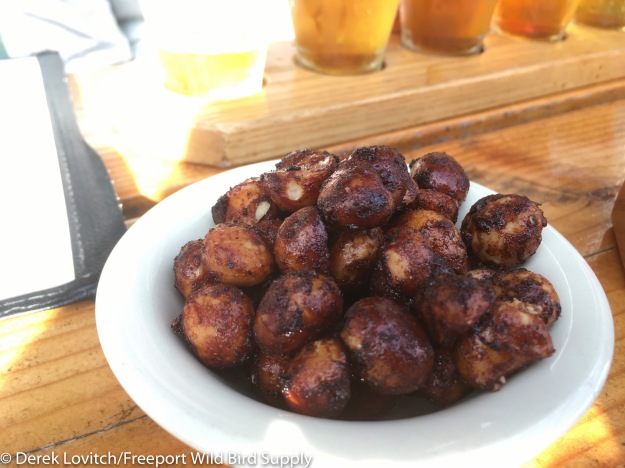
And enjoyed one of the most interesting beers of the trip, their Red Sea of Cacao, brewed with molasses, chocolate, pink sea salt, and pink peppercorns. We at least had sandgrouse and friendship to celebrate! And great food and beer!

1/20: Hawai’i Volcanoes National Park.
On this solemn Inauguration Day, we could think of no better way to celebrate what is great about our country than visiting one of its premier Crown Jewels. Volcanoes are unstable, unpredictable, and at any moment can erupt and cause massive death and destruction. It seemed even more appropriate today for some reason.
And Hawai’i Volcanoes National Park is truly a remarkable, special place. If you haven’t been…you must!
We heard several Omao, spotted a few Hawai’i Elepaio, saw an incredible number of Apapanes, Hawai’i Amakihis, some Nenes, enjoyed White-tailed Tropicbirds soaring around the caldera of an active volcano, and spotted Black Noddies offshore.
However, today was about volcanoes, geology, and Earth at its most raw and primal. There are the steam vents and sulfur deposits,

…not-very-old-in-the-big-picture flows of hardened lava,

…and stories of yesteryear in intriguing petroglyphs.

Eroding lava creates sheer cliffs and arches,

…and some impressive scenery.


Lava tubes and collapsed craters showed where molten magma once flowed.

But it’s Kilauea that steals the show, especially when she’s this active.



And while the caldera, as viewed from the Jagger Museum and observatory is pretty amazing, it was well worth the effort to make a late-day trek out to see the ocean entry, where “new” land is meeting the sea.
We rented bikes for the 3.5 mile ride (on a nice, fairly flat gravel road) to the overlook of the active entry. It’s just far enough to be safe – but also just far enough for decent photos, but this at least gives you a hint at the fireworks.

1/21: Back to the Dry Forest!
Despite our late night viewing hot, molten mag-ma, we were up even earlier than usual the next morning. Lance was not surprised to get the message that we “needed” to try again to see the Palila better, and luckily he was free and willing to take us back up the hill.

The wind was really howling down low, and the forecasts of increasing trade winds really had us worried. We almost called it off. But Palila. So off we went.
Arriving at the Palila Discovery Trail, we were greeted by clear skies and barely a puff of wind. It was simply perfect, and in only about 20 minutes we had great looks at a feeding male Palila. We had even better looks at perhaps the same male a little while later, and Jeannette finally had her satisfying lifer view. No luck with photos, unfortunately, but she did finally get some good Hawai’i Amakihi shots.


We were all a lot happier as we headed downhill this time, back into the howling winds along the coast. We walked Waikoloa Beach in the hopes of stumbling upon a Bristle-thighed Curlew, but alas, all we had were a few Koleas and a couple of Wandering Tattlers.



Birder beach gear.
After lunch, we bid adieu to Lance and worked some local hotspots, padding my state list. It’s rare that it is do far into a Lovitch vacation before we visit a sewage treatment plant, but wow, the Kealakehe Wastewater Treatment Plant was incredible!

I tallied a remarkable 6 state birds, headlined by the mega-rare Marsh Sandpiper that has been present here this winter (we had previously only seen them in Thailand). Western Sandpiper and Buffleheads were a little less rare, but still new for Hawaii for me, as was Cackling Goose…

…and both American (several) and Eurasian (one drake) Wigeon.

Yellow-billed Cardinal was actually new for Jeannette, as well, although we would see a bunch more in Hilo.

Nearby Kaloko-Honokohau National Historic Park was the home of my 100th species in Hawaii – an overwintering “Black” Brant.

Two Laughing Gulls was another nice addition, and we took some time to study and photograph some of the more common shorebirds, like this Ruddy Turnstone – one of the few common, regularly-occurring migrants that spend the winter in these distant islands.

Oh yeah, and a bunch of Green Sea Turtles as well!



We really needed another day (or two, one on each island), but this was our last evening. Pineapple’s in Hilo was a great last meal, where I had the “Hilo Plate,” which was a finer version of the plate lunches we have been eating so often.

And appropriately enough, we parked near this mural.

1/22: Last Day.
There’s never enough time in any vacation, and that reality set in this morning. In fact, despite lodging at the lovely Inn at Kulaniapia Falls for the past three nights, we hadn’t even seen the waterfall in the backyard during the day! Jeannette went for a run in the morning, so I just strolled around the property, enjoying the flowing falls (that was really showing the signs of the heavy rain overnight) and some of the common introduced birds from all corners of the globes: Northern and Yellow-billed Cardinals, Scaly-breasted Munias, House Finches, Japanese White-eyes, and Yellow-fronted Canaries. I also had an unusually cooperative pair of Hwamei – where was the camera when I needed it?

The rest of the morning was spent casually birding Hilo, between rain showers, mostly to procrastinate on heading to the airport. Wailoa River State Park (that produced a number of life birds for me nearly 20 years ago!) offered up a rare Canvasback – my 25th state bird of the trip (here with the two migrant Ring-necked Ducks that were present)

Among the multitudes of mutt ducks of questionable origin,

…there were Hawaiian Coots, another vagrant Belted Kingfisher, and this unreasonably confiding Nene with a satellite transmitter on its back.

We said goodbye to some of the familiar friends of birding in the islands, especially the adorable little Zebra Dove.

Lokowaka Pond yielded another Canvasback among some Lesser Scaup, and a bunch of roosting Cattle Egrets, but there was no better way to finish a trip to Hawai’i than with brunch at the famous Ken’s House of Pancakes, ending the trip the same way we began…with macadamia nut pancakes!
But just to extend the trip a little longer, we picked up some flavors of the island at the airport gift shops.

We departed Hilo for the short flight to Honolulu, passing by Maui which poked out from the clouds,

…including the marathon route.

And then it was time to board our long flight back to the East Coast and begin our journey back to the real world.
Unfortunately, the long flight afforded plenty of time to reflect on said real world, including the endemic Hawaiian birds that we got to see, and the ones on Maui we did not. While we had a great trip on so many levels, including seeing some of these spectacular birds (that truly do put “Darwin’s finches” to shame!), the reality is not as happy as our vacations might suggest. A litany of threats is impacting these birds: development, invasive species, disease, and climate change. The Endangered Species Act – the only reason there are still Nene, for example – is under assault, and without it, most of these endemics don’t stand a chance.
If you enjoyed this blog – and I of course hope you did – please take a moment (I mean, you made it through this excruciatingly long entry; you can spare a few moments more.) to learn more about these imperiled species. The American Bird Conservancy’s Hawai’i program page is a good place to start.
Then, take a minute to call your Senators (here’s a link to all of the local offices where you can leave messages). Tell them to uphold, protect, and increase funding for the Endangered Species Act, and to reject the assault on one of our foremost environmental statutes. Urge them to reject Ryan Zinke for Secretary of the Interior, and any other nominee who has spent a career attempting to gut the ESA.
Because the Palila needs us right now.